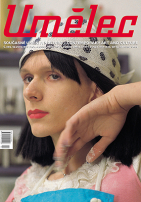| Umělec magazine 2000/2 >> Collective project (Things I Said to My E-Chat Friends) | List of all editions. | ||||||||||||
|
|||||||||||||
Collective project (Things I Said to My E-Chat Friends)Umělec magazine 2000/201.02.2000 art projects | en cs |
|||||||||||||
|
Things I Said to My E-Chat Friends - Collaboration Project
Artist Roarbeer Suwannaphong from Nong Bua Koke, Thailand, commissions agents in Europe and North America to carry out her projects. Due to my contribution to Umělec issue 5-6/1999, to which I introduced one of Miss Suwannaphong’s projects, she approached me to be her agent in helping her to perform her project in the Czech Republic, which I agreed to do. And since Umělec was our bridge, we decided to come up with a premiere of the Czech-Thai joint project for the magazine, which resulted in the photos published here. The photos will be shown at an exhibition in Thailand later this year. Prior to the project, Miss Suwanna-phong intensively researched the on-line chat scene in the Czech Republic, chatting live with many internet users just like any of the tens of thousands of Czech e-chat users. She logged onto chat programs such as X-CHAT and ICQ hoping to find a person with exceptional imagination—usually one can recognize it through the sexual fantasies of e-chat users. And so she met a man named “MrtvejPavouk,” or “DeadSpider,” who switched his/her identity so buoyantly that she decided to ask the person to participate in the project. Miss Suwannaphong is interested in the Western way of visualizing “identity,” a word that doesn’t exist in most Asian languages. Moreover, the fact that the Asian custom of switching genders is considered perverted in the West intrigues her. Miss Suwannaphong thus decided to combine the two and realize the Occidental visualization of “identity” in the manner of Oriental gender swap. She then felt that taking analogue photos of an “identity” that appears in cyberspace would work perfectly to fulfill the subject. With the help of Umělec, we thus commissioned Martin Polák, a Czech photographer who is known for his images of urban and natural landscapes, to visualize the fantasies of “Mrtvej Pavouk.” It turned out that the identity of “MrtvejPavouk” in this—our common—society was Pavel Pražák. Pražák is a former homeless punk who discovered e-chat and started to communicate with people in the city from wherever he was. Currently studying at FaVU VUT Brno (Fine Arts Department of the Technical University in Brno, Czech Republic), his access to e-chat has become much easier. Perhaps you can still come across MrtvejPavouk and Miss Suwan-naphong (her chat nick is “langue de chat”) on e-chat from time to time. Keiko Sei Special thanks to: David Kalika, The Peroutkas, Anežka Veterinary Office, Body-guard Bielický, Mýrnyx Týrnyx for the costumes & Divus Photo: Martin Polák
01.02.2000
Recommended articles
|
|||||||||||||












Comments
There are currently no comments.Add new comment